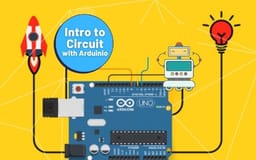$40$15.0063% Off2-5 students group class

Learning Hours
Projects Created
Countries
We are surrounded by electronics: smartphones, computers, TVs, robots, and more! While lots of students have learned to code, few have had the opportunity to build a physical system, which opens up a brand new world. Learn Arduino coding online to create electronics projects for real world adventures at home.
In this class, we introduce students step by step to circuits and Arduino, one of the most popular systems for building robots and smart home systems in the industry. Students will learn how to design simple electronic systems for alarms, home sensing, motor controls, etc, as well as creating code to control these systems. The class uses an Arduino simulator and does not require a physical device. However, if you prefer, an Arduino starter kit can be purchased online for about $40. The same code your student creates in class will work on the device without any changes. It is a great way to explore powerful coding solutions for the physical world. Get started with awesome Arduino projects for kids today!


In this class, we start with the basics of electronics. Students will learn how to create circuits, use resistors, and get introduced to Ohm's law, while building a series of cool projects and experiments. We will also code Arduino to start building smart devices that can sense their environment and respond accordingly.


Students need to have basic coding experiences at the level of our Scratch Ninja 1-3 or Accelerated Scratch 1-2 or equivalent, i.e. understand concepts such as conditional, loop, variable, and events. Requires a computer with Chrome Browser and a mechanical mouse is preferred. Tablets do not work well. Arduino is recommended but not required. If you are getting an Arduino, please get an Arduino Starter Kit which includes some sensors also.
Designed by Stanford, Google & Apple Experts with kids in mind.
We'll help you find the right class, always. Love it or get a full refund.
US-based, background checked, highly trained and 3+ years of experience in their fields.
Show the world you did it. You really did it!
Arduino is a super popular system used to build all sorts of cool electronic projects, from robots to smart home gadgets! In this class, your child will learn how to design circuits and write code to create their own electronic systems. Think smart sensors, motor controls, and even simple alarms – they'll be bringing their code to life in the physical world!
Yes, Arduino is good for beginners looking to get into the world of electronics. The Arduino board can serve as the brain behind almost any electronics project. This versatility, combined with the free software and relatively inexpensive hardware, makes Arduino a great choice for getting started.
This course is a perfect fit for kids in Grades 4-9. To make sure they have a blast and can jump right into the fun, students should have some basic coding experience. This means understanding concepts like loops, variables, and conditional statements, similar to what they'd learn in our** Scratch Ninja 1-3** or Accelerated Scratch 1-2 classes.
You don't actually need to buy a physical Arduino kit for the class. We use a cool Arduino simulator, so your child can learn and build projects completely online without any extra purchases. However, if you'd like them to explore with a real-life device, a starter kit can be bought online for around $40, and the code they create in class will work perfectly on it! It is
Learning Arduino is a fantastic way for kids to see their code come to life in the real world! While many students learn to code on a screen, Arduino lets them build physical systems, connecting their digital skills to tangible creations. This helps them understand how everyday electronics work, boosts their problem-solving skills, and gives them a super valuable head start in robotics, smart technology, and even engineering – truly bridging the gap between software and hardware!
Arduino can be easy and fun to learn. It helps students understand embedded systems. A large and active community shares a wide range of projects, making it easy for novices to find ideas to try out. You can also learn Arduino through online livestream classes and robotics camps that provide step-by-step guidance and help you understand both the "how" and the "why" behind each project.
No, Arduino and Raspberry Pi are different. Arduino is a microcontroller board that is programmed to respond to inputs and outputs. Raspberry Pi is a full single-board computer that runs an operating system. You can program an Arduino using a Raspberry Pi, but not the other way around.
To get started with Arduino, you need the Arduino IDE and, in some cases, a physical Arduino board. For classes, a simulator will be used, so no physical device is required. The Arduino UNO board is one of the most popular options. It features 14 digital input/output pins, 6 analog input pins, a power jack, a reset button, a USB port, and an ICSP header.
An Arduino starter kit is a great way to begin if you're new to the platform. Most kits include a microcontroller and basic components. This Arduino starter kit gives you hands-on experience and includes the latest Arduino UNO controller board, control board, lights, resistors, and more.